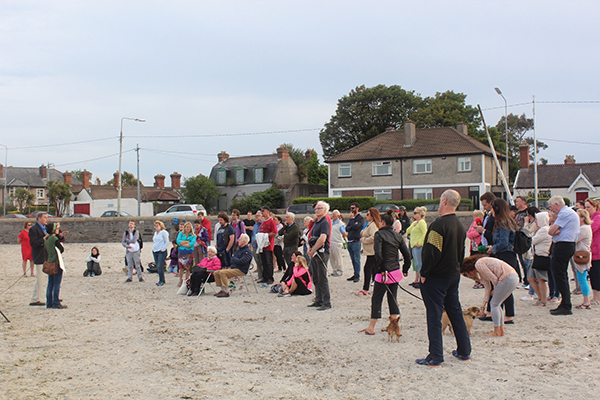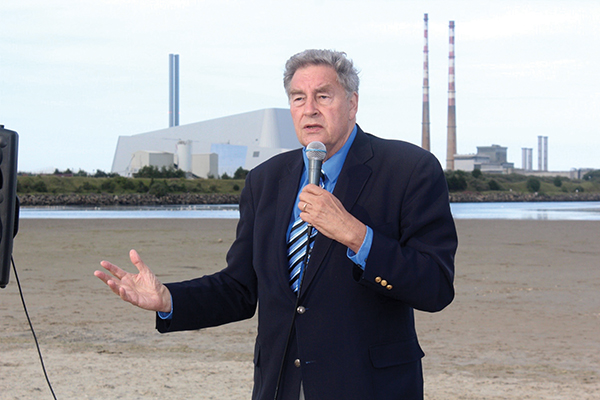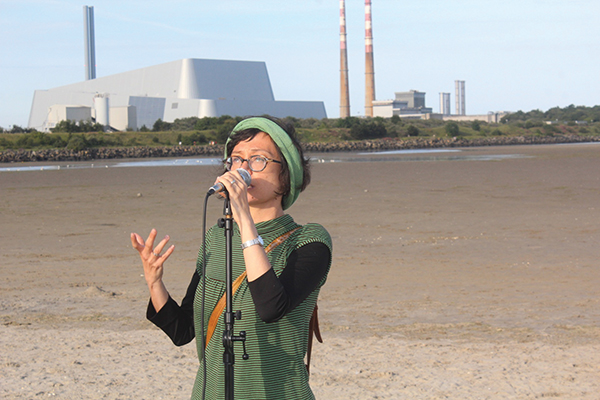
Pictured: Children on beach From left to right: Ronja Hajduk, Luna Morissey, Jan Hajduk and Maya Morissey. Pic by Conor Morrissey.
Renewed efforts to monitor, object or oppose the Poolbeg incinerator have begun to spring to life on a number of fronts. Local groups and political parties have made various efforts to challenge the incinerator amidst fears about its emissions or health effects in general.
During these processes, there have been accidents and problems at the incinerator that have revealed less than optimal operational procedures at best, and possible toxic releases at worst. In light that these were promised never to be at risk of happening during the planning process, it is quite concerning that these have occurred at such an early stage in operations so far.
A number of months ago, the Social Democrats began an online petition on Change.Org attempting to put pressure on the Minister for the Environment, the EPA and Dublin City Council (DCC) to force Dublin Waste to Energy (DWE) to have independent monitoring of their emissions and to have all data used to calculate the emissions made publically available.
On June 7th at 10:45pm there was an “uncontrolled release” of lime at the DWE facility in Ringsend, otherwise known as the Poolbeg Incinerator. Eleven workers at the plant were affected and taken to hospital, in their own cars according to managing director John Daly.
In response to this and other issues surrounding the DWE facility in Poolbeg, a number of groups have developed to oppose Covanta. They cite a concern for public health and a lack of faith in Covanta due to previous incidents in North America as well as their perceived lack of transparency when issues do arise at their facilities. Three meeting were held over the past two months to voice these concerns, demand action and to gain support for protests against Covanta.
People Before Profit held a meeting in Ringsend on June 19th in Clanna Gael, Ringsend, where they brought forward their proposals for dealing with what they saw as issues surrounding the DWE facility. They proposed that a chemical engineer be tasked with examining the DWE facility. They asked that a “sample group of residents from the local area” be examined in an effort to see what effect the incinerator will come to have on the area. They advocated that there be independent monitoring and freely available data from Covanta available to the community at large through their website for greater transparency regarding emissions. Finally, they are calling for a Health Impact Assessment, as has been advocated previously by Professor of epidemiology, Anthony Staines.

Pictured: Attendees listen at the meeting organised by Parents Against The Incinerator.
Before turning the microphone over to Professor Connett, Laura Fano, a member of Parents Against The Incinerator explained why the meeting had been held. Fano explained that parents were “concerned about the potential health impact” on the area. A particular concern of the parents’ group was how near the incinerator would be to the new location for the Shellybanks Educate Together school, which will be beside the strand. Fano was disheartened by “the general attitude of resignation” and the fact that she felt “the community in Ringsend had been bought” through Covanta’s Community Gain Fund. She wanted to send out a message to DWE that “people were watching. They are alert and ready to do something if accidents happen.”

Pictured: Professor Paul Connett, he is a retired Professor of Chemistry.
Connett is a staunch critic of poor waste management in general. He is famous for advocating a zero waste policy, which many would consider unachievable. He explained that many European countries as well as Canada and the United States have reduced their dependency on incinerators due to their known health effects. To give strength to his thesis, he spoke of the city San Francisco in California, which was able to avoid landfill and incinerators for up to 80% of its waste through reuse and recycling. He also referred to Navona, near Turin in Italy, which recycled 70% waste, as a strong argument for this novel approach.
Connett made the dramatic statement that before 1985 dioxins had only been found in the infamous Agent Orange used as a biological weapon during the Vietnam war. He emphasised that a local or community based approach was essential to be successful and that it needed to be a united one with academic backing in order to succeed, as one could not trust government to implement the prudent policy. He was staunchly critical of the Irish Government, whom he stated he advised back in 2005 not to build an incinerator. He stated he “pleaded with and begged them not to build an incinerator,” as Ireland had such good air quality at the time.
Following these two protest meetings in opposition to DWE, People Before Profit’s Annette Mooney, chaired a subsequent meeting on July 12th, in an effort to bring these and other groups together. Many people who attended these events had expressed concern that division had been an issue in the original efforts to prevent the incinerator construction.

Pictured: Laura Fano, Parents Against The Incinerator.
Many people in attendance were angry and frustrated with the incinerator and what they felt was a lack of progress in dealing with it as well as newer issues such as the fly infestation in Ringsend, which was said to originate at the incinerator due to garbage accumulation at the site.
References were made to the controversy surrounding the Bio-burn medical waste incinerator and the successful campaign of protest by Marie Connolly and Mary Lawless. among others, in shutting it down through “civil disobedience.”
It was also a chance to coordinate a response to the incinerator. Cllr Mooney of PBP took notes of additional suggestions and organised the attendees into two groups for dealing with the incinerator. One group to monitor the traffic volume coming and going from the incinerator and the other to push for monitoring of air pollution.
The Social Democrats have participated in follow up meetings and have developed further proposals for monitoring the Poolbeg site. Local Social Democrat candidate, Rory Trainor, has put forward proposals. He is asking “people on a local level to get in touch with their waste management provider” and ask them if they are involved with DWE, and if so to make clear to them that they will not be using them any longer unless they change. He is also seeking monitoring of the number of lorries and trucks serving the Poolbeg site, and where they are coming from, in an effort to gauge any effect they would have on local air quality.
Trainor is also calling for strengthening of the EPA through changes in law that would give the EPA power to designate sites as “high risk sites,” such as DWE. He elaborated that “the EPA be authorised to pre-designate sites or activities as ‘high risk’ and where that designation applies the operator would be obliged to apply higher levels of safety and transparency procedures. Where there are issues arising with such a site or activities there will be a presumption that it is the fault of the operator until they prove otherwise.” Finally they are calling for a Health Impact Assessment in line with People Before Profit.
Joe McCarthy of An Taisce has been a long-standing critic of Covanta. He sits on the DCC’s Special Committee for the Environment. In its most recent meeting, the committee was chaired by Naoise O’Múiri of Fine Gael and was attended by Mr. Dick Brady, Assistant CEO of DCC. Referring to the most recent reports of uncontrolled release of lime, McCarthy claimed that Covanta’s statement that lime alone was leaked is false. McCarthy asserts that there were three incidents at the site, rather than just one reported. His basis for this is official reports that have been submitted to the EPA by DWE.
McCarthy further states that on June 1st they fired up waste burning for the first time. They ran low on water during this time. They suffered a further issue during which “the baghouse pressure dropped and the plant was shut down.” The baghouse contains the “activated carbon”, which absorbs much of the toxins produced during incineration.
On June 5th and 6th, according to McCarthy, waste was fired during the night. The baghouse pressure dropped again. McCarthy states at this time that “there was lime on the ground in the vicinity of the baghouse.” The temperature also dropped below 850 degrees twice due to adjusting pressure and removing bottom ash. The temperature must not drop below 850 when burning waste according to the EPA license issued to Covanta.
McCarthy asserts that these prior incidents culminated in the bag house filter bursting, which lead to the employees coming in contact with toxic waste products such as florans and dioxins, as well as lime.
All of these incidents were contrary to the EPA licence and as such they were issued with three non-compliance notices for failing to report what had occurred on time.
In addition, the EPA have begun legal proceedings against Dublin Waste to Energy Ltd., though what form that is to take is yet to be seen. The Health Safety Authority (HSA) is investigating the lime incident. According to their press officer, Mark Ryan, there was an “uncontrolled release of lime,” leading to a “prohibition notice to cease activity and operation.” However after action by DWE, the HSA are now satisfied that “there is no further issue with the combustion process,” and operations have been allowed to resume. It is “the only incident” with the site that they are “aware of,” according to Mr Ryan. When asked about whether Covanta were being penalised for such actions, Mr Ryan stated that he would not “speculate on fines.”
As part of his research, McCarthy has asked for three figures from DWE – what is the percentage of the flue gas residue being recirculated; how much activated carbon are they using, per tonne or per day; and how much activated carbon has been used to date. For McCarthy these were “matters of fact.” However, there were protestations from others, notably Mr Brady, that he was concluding and that these matters were to be decided on by the EPA and HSA in their investigations in due course.
At the Special Committee for the Environment, exchanges between Mr Brady and Mr McCarthy became heated at times. It was agreed that the figures which McCarthy sought would be provided. In addition McCarthy himself would circulate his sources for his claims about further incidents during the meetings, as well as questions surrounding whether proper procedure was followed in relation to the lime release.
The full consequences for Covanta following on from these controversies and concerns are still to be determined. However local and expert opposition remains against the Poolbeg Incinerator.
Historically, objections to the incinerator were made on largely on grounds of health impacts in Ringsend, Irishtown, Sandymount and the larger Dublin area. There were concerns over whether the contract agreed between Covanta and Dublin City Council allowed for proper oversight by the EPA. In the last number of years further issues have risen regarding the management of DWE’s parent company, Covanta. Fines had been issued in both Miami, America and Durham-York, Canada due to inadequate levels of “activated carbon” used to contain dioxins and other hazardous emissions and excessive emissions, respectively.
An additional concern raised is that the current head of the EPA worked for a number of years for an incinerator company. Laura Burke, head of the EPA since 2004, worked for Indaver Ireland, which tried to establish an incinerator in Ringaskiddy, Cork. It was ultimately objected to by An Bord Pleanala after local opposition and concerns for health.
The plan by Covanta to construct an incinerator in Poolbeg, Dublin has been fought for over 20 years including objections from mostly all Dublin councillors. Despite this, Dublin City Council Chief Executive, Eoin Keegan, pushed it through, using a relatively recent change in law that allowed him to make executive decisions involving waste management without councillors say.
Much of the protests and opposition to the incinerator built by Covanta under a subsidiary company, Dublin Waste to Energy Ltd, had subsided. The exact reason is a matter of controversy involving a fund set aside by Covanta for local investment that local groups could apply to, which helped minimise opposition and buy silence.
However the interest in challenging the incinerator has emerged in a number of new groups and individuals who are still willing to challenge the incinerator, especially given recent incidents. The issue has now changed from one of prevention to minimisation of the perceived risk to health, by attempting to closely monitor the facility and to ensure there are not excessive toxic emissions released from the plant.
By Kevin McSharry



